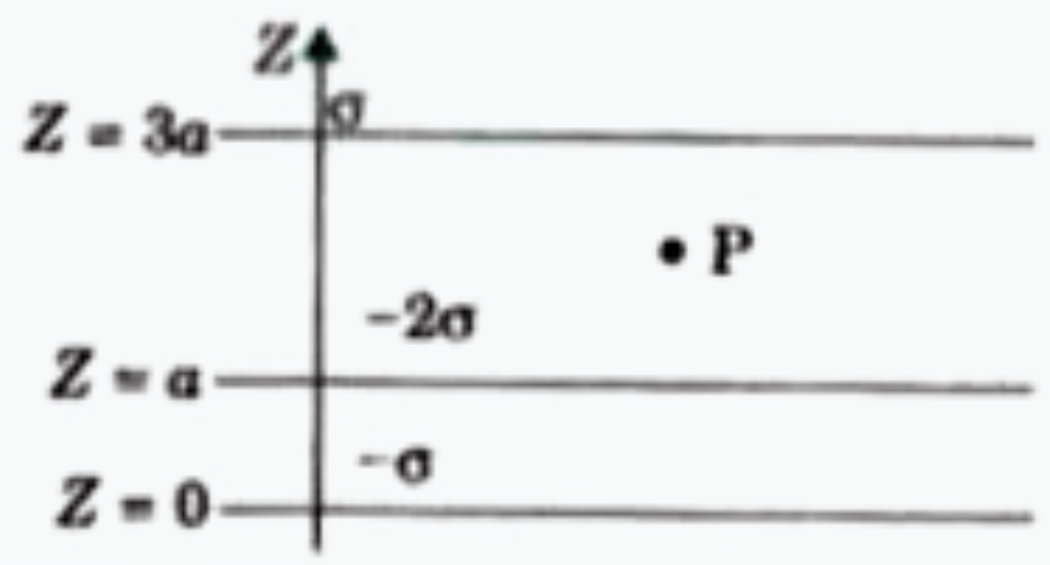Complete Solutions to COMPETITION FILE ( Objective Question (BC.MCQ)) of chapter ELECTRIC CHARGES AND FIELDS of Class 12 book with complete answers and questions
| Class 12 | PHYSICS |
| Chapter | ELECTRIC CHARGES AND FIELDS |
| MODERN PUBLICATION | COMPETITION FILE ( Objective Question (BC.MCQ)) |
| Number Of Questions | 10 |
| Academic Year | 2023-24 |
Let `E_1(r)`, `E_2(r)` and `E_3(r)` be the respectively electric field at a distance r from a point charge `Q`, an infinitely long wire with constant linear charge density `lambda`, and an infinite plane with uniform surface charge density `sigma`. If `E_1(r_0)=E_2(r_0)=E_3(r_0)` at a given distance `r_0`, then
View SolutionCharges Q, 2Q and 4Q are uniformly distributed in three dielectric solid spheres 1, 2 and 3 of radii `R//2`, R and 2R respectively, as shown in figure. If magnitude of the electric fields at point P at a distance R from the centre of sphere 1,2 and 3 are `E_1, E_2 and E_3` respectively, then



View SolutionThree positive charges of equal value q are placed vertices of an equilarteral triangle. The resulting lines of should be sketched as in :-
View SolutionA Gaussian surface in the fig. is shown by dotted line. The electric field on the surface will be :-

View SolutionThree large plates having uniform surface charge densities are shown in figure. Electric field at point 'P' will be :

View SolutionA spherical portion has been removed from a solid sphere having a charge distributed uniformly in its volume as shown in the figure. The electric field inisde the emptied space is

View SolutionUnder the influence of the Coulomb field of charge `+Q`, a charge `-q` is moving around it in an elliptical orbit. Find out the correct statement(s).
View SolutionThree concentric metallic spherical shells of radii R, 2R, 3R, are given charges `Q_1`, `Q_2`, `Q_3`, respectively. It is found that the surface charge denisties on the outer surfaces of the shells are equal. Then, the ratio of the charges given to the shells, `Q_1:Q_2:Q_3`, is
View SolutionConisder a neutral conducting sphere. A poistive point charge is placed outisde the sphere. The net charge on the sphere is then
View SolutionConsider a uniform spherical charge distribution of radius `R_(1)` centred at the origin `O`. In this distribution a spherical cavity of radius `R_(2)`, centred at `P` with distance `OP = a = R_(1) - R_(2)` (fig) is made.If the electric field inside the cavity at position `vec(r )`, then the correct statement is

View Solution
COMPETITION FILE ( Objective Question (BC.MCQ)) questions and complete solutions for chapter ELECTRIC CHARGES AND FIELDS of MODERN PUBLISHERS PHYSICS (HINGLISH) of Class 12
All Exercises from MODERN PUBLICATION Class 12 PHYSICS ELECTRIC CHARGES AND FIELDS
- Chapter Practice Test
- COMPETITION FILE ( Objective Question (Assertion Reason ) )
- COMPETITION FILE ( Objective Question (BB.MCQ))
- COMPETITION FILE ( Objective Question (BC.MCQ))
- COMPETITION FILE ( Objective Question (C.MCQ))
- COMPETITION FILE ( Objective Question (D.MCQ) Passage )
- COMPETITION FILE ( Objective Question (A.MCQ) )
- COMPETITION FILE ( Objective Question (BA.MCQ) )
- COMPETITION FILE ( Objective Question (BA.MCQ))
- COMPETITION FILE ( Objective Question (Integer))
- COMPETITION FILE ( Objective Question (Matching ) )
- COMPETITION FILE ( Objective Question (Matrix))
- Conceptual Questions
- Higher Order Thinking Skills & Advanced Level (Questions With Answers)
- Ncert File (Ncert (Exemplar Problems) )
- Ncert File (Textbook Exercise)
- Practice Problems
- Revision Exercises (Additional Question)
- Revision Exercises (Fill in the Blanks )
- Revision Exercises (Long Answer )
- Revision Exercises (Numerical Problems )
- Revision Exercises (Short Answer )
- Revision Exercises (Very short)
- Solved Example
- Tough & Tricky Problems